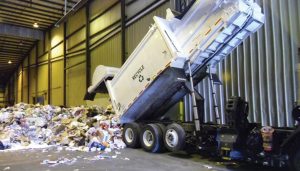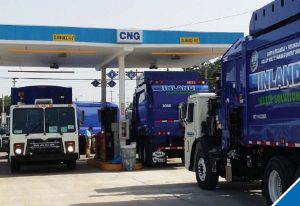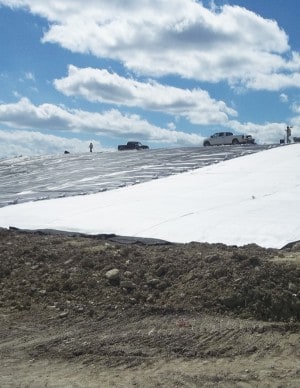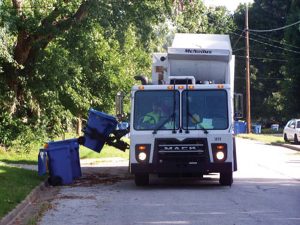Doubling in size in the last 36 months, Inland Waste Solutions has stayed focused on transitioning to CNG, keeping up with changing regulations and growing into additional markets in the upcoming year.
Inland Waste Solutions (Austin, TX) was started in 1953 by Robert Smith, Sr., a retired air force pilot who had originally set the company up to handle contracts for the local government, such as ground maintenance and operating the PX (grocery and general stores) pre-installations on Fort Hood’s base. In 1964, the company started branching out with residential service in the solid waste division. At that point, Smith Sr. saw the opportunity to go after residential contracts with municipalities, which they continued following through with until Smith Sr. passed in 1987. When that happened, sons Robert and Jim broke up the company, with Jim taking half and renaming it Red River, while Robert took Inland Waste and continued to grow it. In 2012, Robert was looking to decrease his role in the company and he and Monty Davison contacted Bart Begley to see if he wanted to buy the company. In December 2012, Davison and Begley bought 75 percent of the company with the eye on taking what Robert had built and changing it to not only having a municipal focus, but also concentrating on becoming a full-service company.
Now, in eight different states, including Arkansas, Texas, Kansas, Missouri, Delaware, Tennessee, Georgia and Wisconsin, Inland Waste provides front-load services, commercial services, industrial services and recycling services to approximately 210,000 people. The company also operates a couple of small transfer stations and two landfills. With 270 vehicles, Inland Waste runs 205 routes with the additional trucks kept in rotation as backup and seasonal vehicles to fill heavy times.
Continuing Growth Through Uncertain Times
Doubling in size in the last 36 months, Inland Waste’s revenue has gone from $22 to $44 million and they have added on 122 employees. According to Begley, CEO, the company insulated itself from the problems with the soft recycling market by focusing on the hauling aspect of the business. “Living through this before in both the 1990s and early 2000s, we’ve seen this drastic sway in commodity pricing so we insulated ourselves by just hauling and providing curbside recycling. Recycling is so cyclical that you can make a lot of money, but you can also lose a lot of money. Right now the markets are so soft that we made a decision not to get into the MRF business. Instead, we charge for the hauling and our customers set the agreements with the recycling facilities. Unfortunately, I don’t see the market becoming less soft in the future because of the way our economy and China’s economy is going; it all hinges on how the Asian markets are buying and right now they are struggling.”
One thing that Inland Waste has done that Begley is quick to point out is a couple of years ago when diesel went through the roof, the company saw the opportunity to start getting into the CNG market. Another reason was that the trucks that they were running according to the 2007 emission changes with re-gen engines (where they have to take the exhaust back through the engines and burn the excess off), were having a lot of problems because of the computer issue with the technology. It was also hurting the company’s fuel economy, so they started focusing on transitioning to CNG. “Our first entry into CNG was June 2013 when we made a deal with the city of Augusta to change from diesel to all CNG trucks to service the city. We bought the new CNG trucks and have been running them for over 2 ½ years now and have had great success with it,” says Begley. “When we entered into the Memphis market, we saw an opportunity to build our own CNG station. It was one of the easiest projects we ever did. It has been a worry-free system, saved us a lot of money and made us very efficient in the way we operate.” Working with TruStar Energy and Memphis Light Gas & Water to get the size pipes needed, Inland Waste found that was really an effortless project on their part. “It took us 90 days from start to finish from the ground up. The longest wait time was the equipment,” laughs Begley. “There were no big permitting hurdles, the city helped us with everything because it was such an important project.”
One of Inland Waste’s landfills they operate is located on the Fort Hood property. Taking in about 100 to 110 tons per day, the landfill is really not large enough to take methane from, however, about four months ago, Inland Waste started working with Fort Hood on an organics program out of their cafeterias. “We are collecting those organics separately and taking them from Fort Hood and driving them 45 miles south into the city of Austin to where there is a private person that is turning the material into compost. So far, it’s been pretty successful,” says Begley.
The other landfill Inland Waste operates is in the state of Arkansas and this is a facility that requires closure. They took it over from a now defunct solid waste authority and they have a post-closure bond, but its not enough to close it at this point, so the state of Arkansas still has to deal with it. “We took it over on an operating basis, taking out all of the leachates, keeping the slopes intact, keeping the roadway open and securing the area until closure, which won’t happen for a while,” says Begley.
Internal Operations
When it comes to internal operations, each driver goes through a two-week training period, where they are road tested and they must watch a series of videos, including on safety and how they operate as a company. After that process is complete, the person then rides with an experienced driver for two days, then they are shadowed by a supervisor for a week. The two-week program puts them through everything from top to bottom and then they are checked out for their capabilities out on the road. “Our folks that work for us internally answering the phones are also required to go out on trucks. They see what the drivers are doing every day and for them to not understand what we do, it would be tough for them to help solve problems, so we have them periodically ride along with the drivers,” says Begley.
After finding that it was not very productive to have a safety manager at each of their locations because of the internal comradery and level of available talent, the company decided to look at third party options for safety programs. “First we went to our insurance company and asked what do you recommend for a third-party program. And two years ago, we actually ended up hiring a third-party, Life and Safety, to do our safety program for the whole company. They do site visits on a schedule and after each one, they’ll give recommendations, discuss any deficiencies and put programs in place to take care of them. They will also give us daily training tidbits and hold weekly training at our safety meetings. It really puts us ahead of the curve for a company of our size to have a resource like that at our fingertips. They are constantly coming to us with ways to improve our safety and it has helped us a lot,” explains Begley.
As far as community outreach, Inland Waste works with the local sheriff’s office and law enforcement to provide a neighborhood watch. Begley points out that because their trucks are out on the routes at the times that most crimes occur—early morning, late night—their front-load, commercial, roll-off, residential drivers are all trained on what to look for and who to call when they see suspicious activity. “We actually helped the law enforcement authority in Volusia County, FL, alerting about somebody breaking into a house. It is an effective program. What better way to get 100 eyes on the street?”
In addition, Inland Waste visits elementary, junior and high schools for discussion and career days as well as supporting their extracurricular activities, from the band to music to the arts and sports in each community.
Addressing Challenges
Begley does stress that there are a number of challenges in the waste and recycling industry that he sees and is currently experiencing. As he mentioned previously not only are the recycling commodities pricing putting a hinder on the fragile state of the economy as it relates to the C&D streams, but he also says that it is tough finding qualified mechanics and really strong employees to operate in their facilities. “We have had a hard time. Back in the 1980s, we could find them readily; by the 1990s it started to get a little tough; in the 2000s it really got tough. There are not very many people coming out of high school and college wanting to be a diesel mechanic for a solid waste company,” says Begley. “However, since we are at Fort Hood, we noticed that we were able to get qualified mechanics coming out of the military, so we went to them and asked how the process worked. Each of the cities that we are in has a job advisor for the military that helps veterans with job placement, so we’ve used the military as our mechanics’ supplier—they are trained, have diesel experience, do well under adverse conditions and are, in general, very well-qualified. We have been doing this the last two years. It has resulted in low turnover and incredible employees.”
In order to keep up with the changing regulations from state to state, Begley explains that before Inland Waste begins business in a new state, each one is categorized in their database into what state, county and city. The database works to keep the company in the know because they can review any kind of changes that might come down from lawmakers. There is one database manager who reviews the information monthly with each of the division managers. “We are constantly looking at that, as well as our performance bonds for our contracts that have to be renewed, permitting, environmental requirements, OSHA, DOT issues. It is up to the division managers to update the database and the database manager will go over what each needs to do every month when they get together for review.”
Doubled in Size
Within the next 36 months, Begley’s goal is to continue to grow the company and double in size again. Inland Waste is not only in the middle of two deals that would put new CNG stations into Arkansas and Texas, but they plan on finishing the transition to CNG in the Memphis area. “We really want to continue down the growth path we are on. We’ve got some acquisitions that we are working on for this year and we have plans to change another 20 trucks to CNG in the Memphis market. We currently run about 50 routes out of that area and we have 24 CNG there already; so, I would like to changeover the rest of that market.” | WA
For more information, contact Bart Begley at [email protected]. or visit www.inlandwaste.com.
Phots 1&2: In eight different states, including Arkansas, Texas, Kansas, Missouri, Delaware, Tennessee, Georgia and Wisconsin, Inland Waste provides front-load services, commercial services, industrial services and recycling services to approximately 210,000 people.




